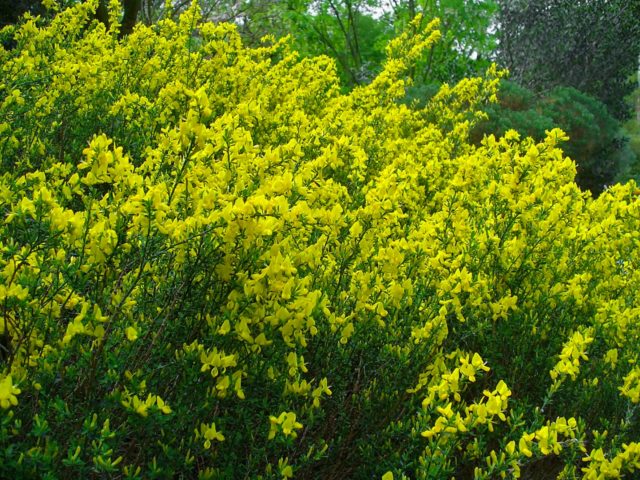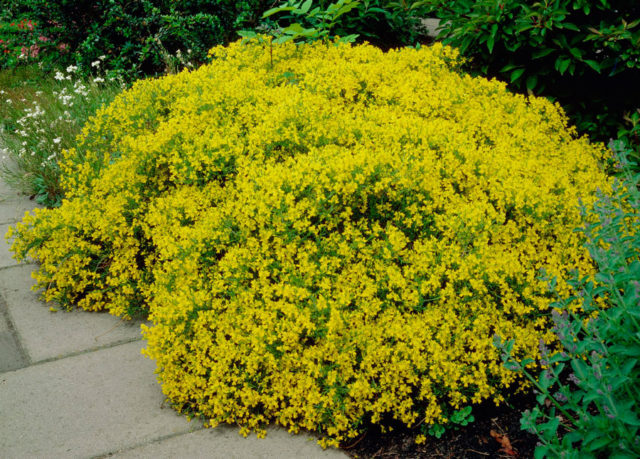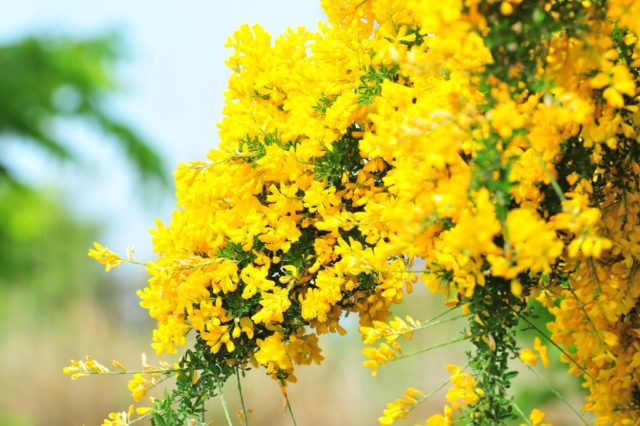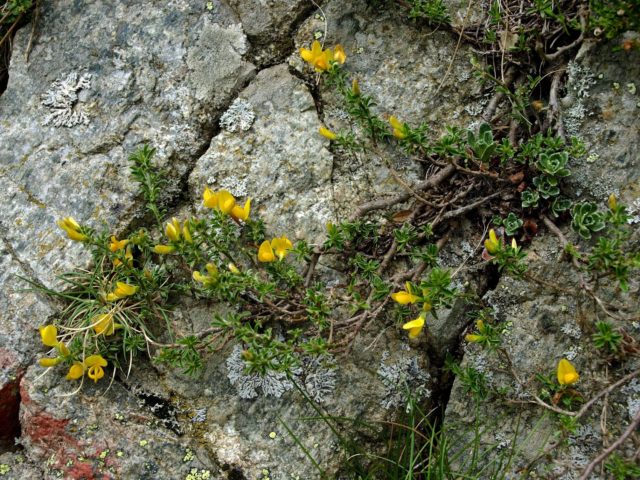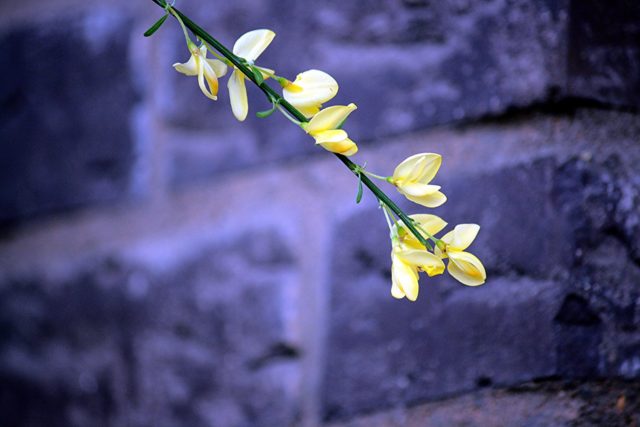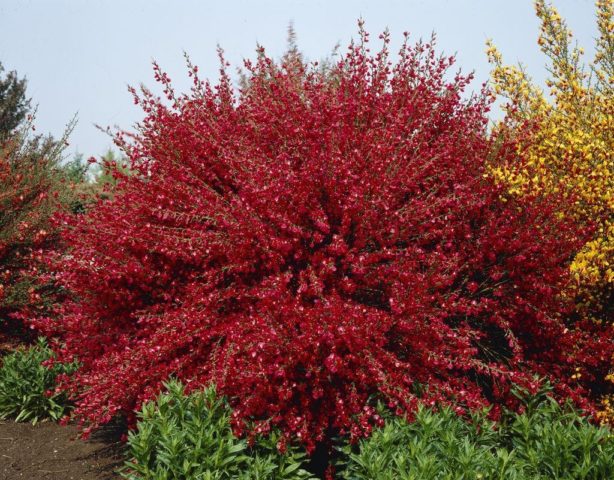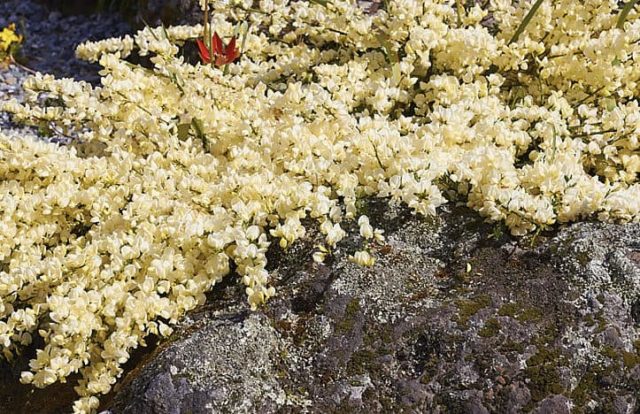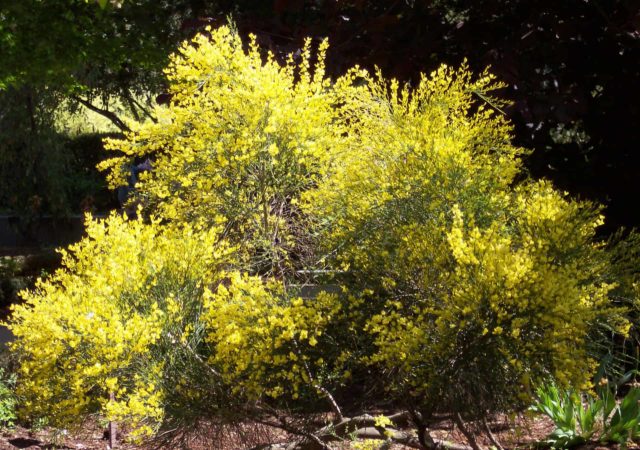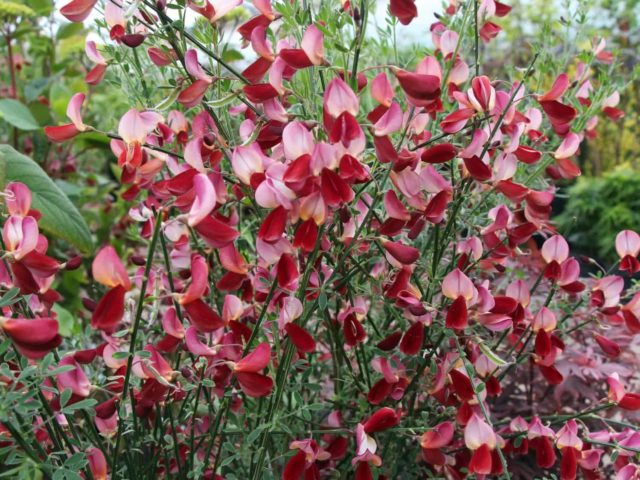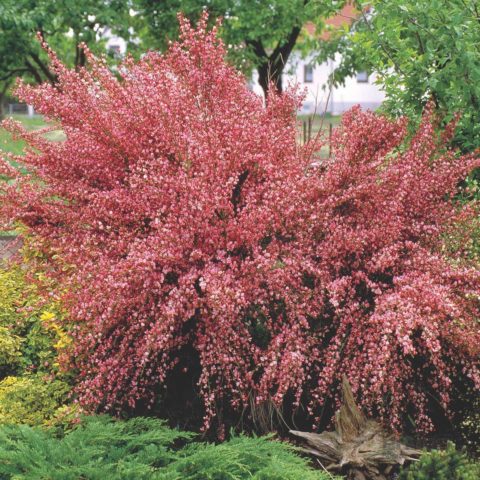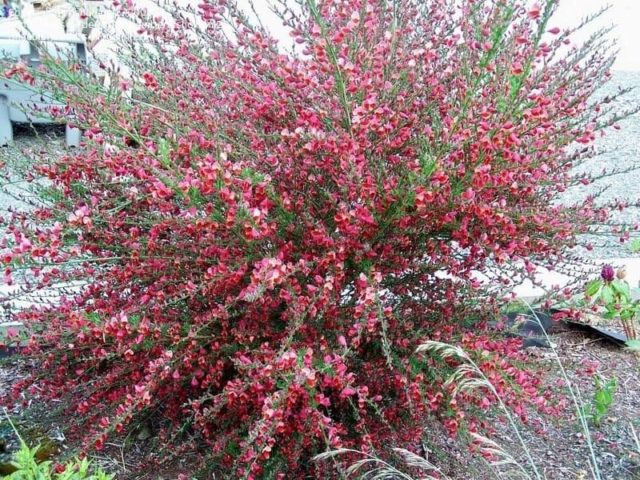Content
Broom is an ornamental shrub, represented by a large number of varieties, many of which are adapted for cultivation in Russia. In landscape design, this garden culture is valued for the fact that it retains its decorative effect until the very frost. This quality allows the garden to be revitalized in late autumn, when all plants have faded and shed their foliage.
What is broom
Broom (Latin Cytisus) is a shrub of the legume family. Some varieties and species are small trees.
Broom is widespread as a deciduous culture, but evergreen varieties with small thorns are sometimes found.
What does broom look like
Broom (also Tsitius or Zharnovets paniculata) is an ornamental spreading shrub or tree that grows from 1 to 3 m in height. The shoots of the plant are smooth to the touch. The color of the branches of the broom is at first bright green, but then they lignify as the shrub grows. Some varieties are distinguished by slight pubescence of the branches and grayish streaks on the bark. Young shoots sometimes sag under the weight of leaves and flowers, as they are quite elastic.
The leaves of the broom are attached to the shoots with short petioles and are arranged alternately on them. The foliage is bright green. Each leaf blade is represented by a combination of three oval lobes, with the leaves at the ends of the branches being especially closely connected. The length of individual leaves is on average 3-4 cm.
The color of the petals of broom flowers varies depending on the variety: these are purple, yellow or cream tones. Varieties with snow-white flowers are in great demand, and there are also two-color varieties.
Where does the broom grow
Wild broom is found in Western Siberia, North Africa, Europe and western Asia. The highest concentration of broom bushes is observed on light and dry soils, usually sandy or sandy loam. Also, wild broom grows well in places where limestone comes to the surface.
When the broom blooms
Cultivated varieties bloom in May, sometimes in June. In some varieties, flowers appear even before the shoots are covered with leaves.
Flowering lasts an average of about a month. First, the bush forms spongy buds, then the flowers open and look like bells. The length of the petals is 2-3 cm, large flowers are rare. They are located on the shoots not singly, but in groups, forming racemose inflorescences.
Since the broom is a plant from the legume family, flowering ends with the formation of fruits, which are small beans.
How many years does the broom live
Depending on the variety, the broom has a different lifespan. On average, this is about 10-15 years, but there are specimens that live up to 18-20 years.
Broom in landscape design
Broom is planted in garden plots, but some varieties can also be bred indoors. In terms of design, both single plantings of a bush and group compositions of a bush look equally good. If you plant the bushes in a row, close to each other, you can grow a spectacular hedge from them. Large boulders of irregular shape look good near homogeneous thickets of broom.
The following crops will be the best neighbors for the shrub:
- conifers;
- lilies of the valley;
- antennae;
- lavender;
- juniper;
- weigela;
- heather;
- chubushnik.
Very often, broom is used to create rock gardens and heather gardens. Some varieties will serve as a wonderful decoration for sandy slopes. At the same time, in no case should you plant a shrub near reservoirs with live fish - the substances contained in it can negatively affect the fauna of ponds and lakes.
Broom species
There are about 50 varieties of broom. The most common in Russia are the following types:
- coronary;
- creeping;
- crowded;
- early;
- Russian.
These species are best adapted to growing in the climatic conditions of Russia.
Broom
Corona broom (Cytisus scoparius) is a deciduous shrub with thin and rather flexible shoots. Plant height is 2.5-3 m. In Europe, it is the most common type of broom.
The branches of the shrub are reddish and slightly pubescent. The flowers are light yellow, small - about 2 cm in diameter. The foliage of the corona broom is regular. The sheet plate is elongated. In shape, it is an oval. The fruits of this species are oblong, slightly flattened. Each bean contains 2 seeds.
The foliage of the crown broom falls early - this is how the shrub begins to prepare for winter. In landscape design, this type is used mainly for decorating rock gardens and solitary planting on the lawn.
Broom creeping
Creeping creeper (Cytisus decumbens) is a plant native to southern Europe. As the name implies, the height of the shrub is small - only 20-25 cm. The shoots of this species are green, pubescent and ribbed to the touch. The color of the leaves is dark. The leaf plate is oblong-lanceolate, covered with villi on the underside. In the axils of the leaves are paniculate inflorescences, which consist of many small flowers. Their petals are rich yellow, sometimes varieties with dark flowers are found.
The species is distinguished by abundant flowering, which gives the plant incredible splendor in early summer.
In landscape design, shrubs are used to decorate rocky gardens and group compositions in combination with conifers.
The fruits of this species are beans 3 cm long.
Crowded broom
The crowded broom (Cytisus aggregatus) is a low-growing shrub, the average height of which is 25-50 cm.The diameter of the plant can reach 70-90 cm.
The flowers of this species are bright yellow, small. Crowded broom varieties begin to bear fruit only 3 years after planting in open ground. What distinguishes this variety favorably is the excellent germination of seeds - more than 90% of the seeds take root.
The frost resistance of the species is average. It is better to grow it in the south of the country or in mid-latitude conditions, since at low temperatures, annual branches can freeze on it.
Early broom
Early broom (Cytisus praecox) is a medium-sized variety with arched shoots.The height of the plant is 90-100 cm, but there are also specimens reaching one and a half meter in height. The branches of this species are densely covered with leaves of a rich green color. In shape, the leaf blade of the early broom is lanceolate, slightly elongated. The length of the leaf is 2-3 cm.
In appearance, it is a rather lush, strongly branched shrub, characterized by a dense crown, but the shoots themselves are very thin and delicate. When hiding for the winter, they should be handled with extreme caution.
Among other species, this one has a rather sharp aroma of flowers. The shrub blooms in May, forming many bright yellow flowers, collected in panicle inflorescences.
The species is unpretentious and grows on all types of soil, but it develops better on sandy soil. The advantages of this variety include good frost resistance.
In landscape design, solitary plantings are included in the scope of the shrub, but it also looks impressive in group compositions.
Russian broom
The Russian broom (Cytisus ruthenicus) in the photo is a medium-sized bush with erect shoots and bright yellow flowers. The height of the plant reaches 1.5 m, sometimes there are bushes growing up to 2 m.
The leaves of the variety are small, triple, like other broom species. The shape of the leaf plate is oval; on the reverse side it is slightly pubescent. The size of the leaves does not exceed 3 cm in length. The color of the foliage is gray-green.
In the axils of the leaves of the Russian broom, there are small inflorescences from a group of 4-6 flowers. The flower petals are yellow.
On the territory of Russia, this species grows in the wild in western Siberia. The bush blooms in May. According to the description of the Russian broom, its flowering lasts 25 days. Sometimes the bush can bloom a second time in August-September.
It is possible to grow this species both in a summer cottage and in an urban setting.
Broom varieties
The varieties grown in Russia bloom quite early. In May, the first flowers appear, and the shoots grow until late autumn. This is the advantage of broomstick over many other horticultural crops - it retains its decorative effect for a long time, especially if it is an evergreen variety.
Boskoop Ruby (Cytisus Boskoop Ruby)
Variety about 2 m high with beautiful flowering. The bush forms a large number of flowers in early May and soon becomes almost completely covered by them. The leaves of the Boskop Ruby broom are small - the length is only 1-2 cm, which is why during flowering ruby buds overlap the green mass of the plant.
If you look at the shrub from a distance, it seems that even the foliage is red.
The Boskop Rudi variety is frost-resistant, it is better to cover it in late autumn, before the onset of the first frost. To make the bush look attractive, it is shaped.
In landscape design, Rudy's Boskop is used as a spectacular specimen shrub, but it also looks good when surrounded by dark green conifers.
Albus (Cytisus praecox Albus)
It is a 1.2 m high variety that blooms in May. For the winter, he does not need additional shelter, but it is better to shovel snow to the plant, which will serve as a natural insulation.
The variety prefers light sandy soils and is compact in shape. The shrub forms a dense spherical crown and looks good in rock gardens.
The Albus variety blooms with white flowers. Flowering continues until June.
Andreanus (Cytisus Andreanus)
Variety Andreanus does not grow higher than 1.5 m, the crown width reaches 2-2.5 m. Broom blooms in May-June. The inflorescences of the variety are dense, formed from many yellow-red flowers.
The shrub is distinguished by its unpretentiousness, it grows even on scanty stony soils, its requirements for lighting are high. In the shade, Andreanus does not develop well.
Olgold (Cytisus Allgold)
The Olgold variety is an early flowering variety up to 1.5 meters high. The diameter of the shrub reaches 2 m. The leaves of the Olgold variety are light green, small. The flowers are yellow and fragrant.
The variety is referred to as frost-resistant varieties that develop well in urban conditions. The preferred soil type for this shrub is sandy soil.
Palette (Cytisus Palett)
Palette is a compact shrub with pink and red flowers. Plant height 1.5 m. The variety blooms from May to June.
Holland (Cytisus Holland)
Holland is a spectacular ornamental variety up to 1.5 m high.The shrub grows up to 1.5 m in diameter.
Flowers of the variety are pink-red, small. Holland blooms early - in April the first flowers appear. Flowering ends in May.
The advantages of this variety include immunity to air pollution and endurance. For full development, the plant needs minimal care.
Burkwoodi (Cytisus Burkwoodii)
Burkwoodi is an elegant shrub about 2 m high. It blooms profusely and grows even on poor soils.
The flowers of the variety are red-coral, along the edges of the petals have a light edging of a golden hue. The flowers reach 3 cm in diameter.
The advantages of the variety include drought resistance. He goes without water for a long period of time.
Conclusion
The broom attracts gardeners with its unpretentiousness and endurance. It is easy to look after him, but he does not get sick often, especially if you follow the agricultural techniques of planting and basic requirements for the composition of the soil. The broom is watered only in hot weather, which further simplifies its care.
You can learn more about the features of growing broom from the video below:
